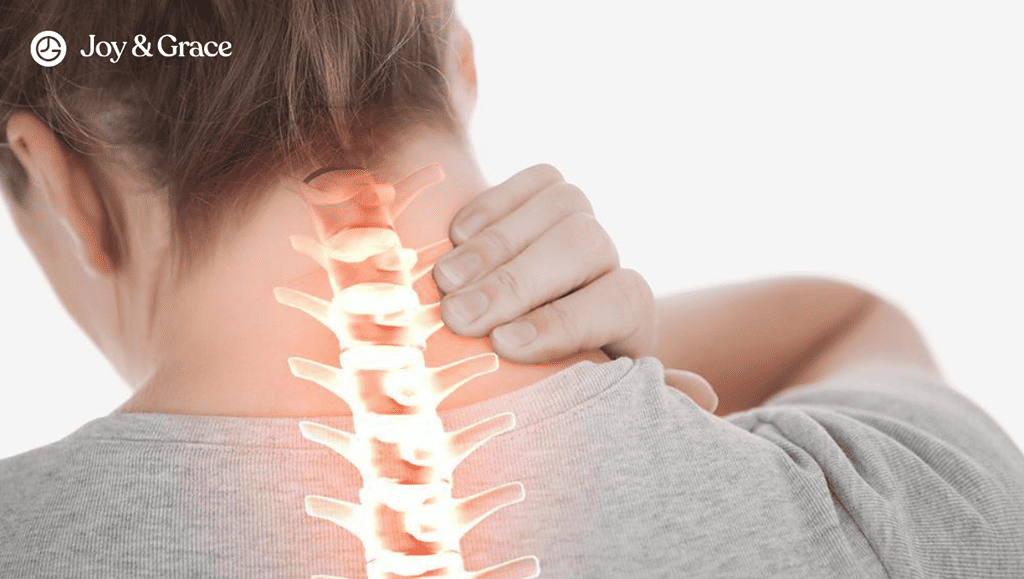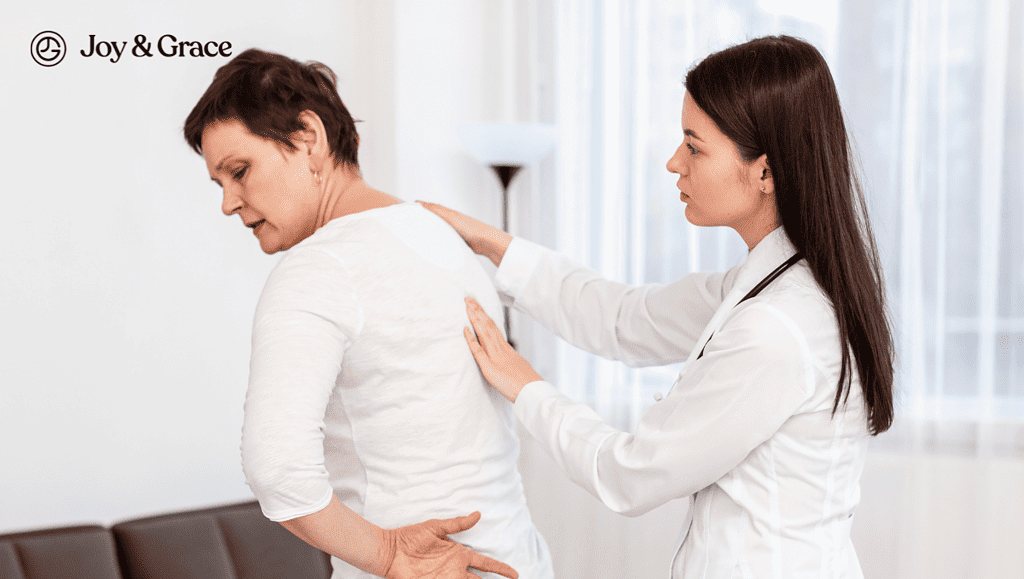You've picked out a beautiful, supportive, and stylish bra, but you notice an undeniable twinge in your shoulders as the day passes. Is that pain connected to your sassy pick, or is it just a coincidence?
A lot of times, we overlook the possibility that a simple thing like wearing a tight bra can be the culprit behind shoulder or neck pain.
Can a bra cause shoulder and neck pain? We'll discuss the connection between your shoulder pain and your bra and suggest ways to alleviate the discomfort. After reading, you'll be better equipped to strut your style without letting your bra straps weigh heavily on your shoulders.
Can Tight Bra Straps Cause Shoulder Pain?
Yes, tight bra straps can indeed cause shoulder pain.
This issue is surprisingly common. Women often wear bras that don't fit correctly, mainly due to misunderstandings about proper bra size and fit. According to a study, 80% of women wore the wrong bra size. 70% wore smaller bras, while 10% wore a larger bra size.
Additionally, many tend to over-tighten their bra straps to provide more lift, but this is a misconception. A well-fitted bra should provide support from the band, not from the straps.
When the bra straps are too tight, they can place excessive pressure on the shoulders and the surrounding muscles. This can lead to discomfort and pain.
The shoulder area is a complex structure with various muscles, tendons, and ligaments. When you wear a bra with straps that are too tight, the pressure can cause:
- Muscle strain
The constant tension on the shoulder muscles can lead to muscle strain and fatigue, which may result in pain and soreness.
- Posture issues
The strain from tight bra straps can affect your posture, causing you to hunch forward to relieve the pressure. This may lead to and worsen shoulder and neck pain.
Can Bra Straps Cause Shoulder Problems?
Yes. In a study, bra straps were found to actually affect the way your shoulder moves when you raise your arms. According to the study, when women wore bras, the shoulder blade:
- Moved less upward
- Rotated less internally
- Tilted less backward
On the other hand, the shoulder joint itself had a greater upward movement when bras were worn.
This may increase the risk of overloading your shoulders and developing shoulder problems.
Tight bra straps may also cause a condition called costoclavicular syndrome, or “bra strap syndrome.”
How Can A Tight Bra Cause Shoulder And Neck Pain?
Costoclavicular syndrome was first identified in soldiers who carried heavy backpacks. The problem occurs because the clavicle (collarbone) presses down on the first rib. This can put pressure on the nerves and blood vessels in the area.
There are three main ways this can happen:
- The clavicle moves down towards the first rib. This can occur when someone slumps their shoulders or has poor posture. This narrows the space between the clavicle and the first rib, squeezing the nerves and blood vessels.
- A muscle called the subclavius causes the clavicle to push down on the first rib when it’s tight. This happens in people who wear tight bra straps or in obese, middle-aged, or older women with heavy breasts. The pressure from the bra straps or the weight of the breasts causes the clavicle to press on the first rib, compressing the nerves and blood vessels.
- The first rib moves up towards the clavicle. It's often due to tight muscles called the anterior and middle scalenes and the subclavius. This can also happen in people who have difficulty breathing.
When you have breathing problems, your body usually recruits your accessory breathing muscles. These include the scalenes.
When this happens, your scalenes lift your first two ribs. Labored breathing may also cause tension in your scalenes. Tense and painful scalenes can also cause costoclavicular syndrome.
Sometimes, a combination of these factors can contribute to the condition, with the clavicle pushing down and the first rib moving up. This further compresses the nerves and blood vessels in the area.
Is Costoclavicular Syndrome The Same As Thoracic Outlet Syndrome?
Yes. A more recent term for costoclavicular syndrome is thoracic outlet syndrome. Other names include:
- Cervical rib syndrome
- Scalenus anticus syndrome
- Subclavius tendon syndrome
- Musculus pectoralis major syndrome
Thoracic Outlet Syndrome (TOS) is when the nerves or blood vessels in the thoracic outlet become compressed or irritated. The thoracic outlet is the space between your collarbone and first rib.
The thoracic outlet is a narrow passageway through which nerves, arteries, and veins pass from your neck to your arm.
Thoracic Outlet Syndrome (TOS) can be categorized into three main types based on the structures compressed:
Neurogenic Thoracic Outlet Syndrome (NTOS)
This is the most common type of TOS and is more common in women. It accounts for greater than 95 percent of cases of thoracic outlet syndrome. It involves compression or irritation of the brachial plexus.
The brachial plexus is a network of nerves that originates from the spinal cord in the neck and runs down the arm. When these nerves are compressed, it can cause pain, weakness, and numbness in the shoulder, arm, and hand.
Any activity requiring raising arms or hands or using them for a long time usually worsens the symptoms.
Some of these things include:
- Reaching up, such as when you:
- Brush your hair
- Hold the phone to your ear
- Get something from a cabinet
- Lifting up
- Typing or working on a computer
- Driving for long periods of time
Vascular Thoracic Outlet Syndrome (VTOS)
VTOS occurs when the blood vessels are compressed or obstructed as they pass through the thoracic outlet. This particularly affects the subclavian artery or vein. This can lead to symptoms such as swelling, discoloration, and coldness in the arm and hand.
VTOS is way less common (around 3-5% of all TOS cases) than NTOS but can be more serious. VTOS can potentially lead to blood clots or other vascular complications.
Arterial Thoracic Outlet Syndrome (ATOS)
Arterial Thoracic Outlet Syndrome (ATOS) occurs when the artery in your thoracic outlet is compressed.
If left untreated, ATOS can lead to severe health complications. For some individuals, the pressure on the artery can cause it to expand and weaken, creating what is known as an aneurysm.
This poses a serious risk, as an aneurysm is a potentially life-threatening condition. An aneurysm results in the artery wall becoming thin and prone to rupture.
ATOS is considered the least common type of TOS, accounting for around 1-2% of all cases.
Can A Tight Bra Damage Breast Tissue?
In very rare cases, tight bra straps can cause a condition called Mondor’s disease. Mondor’s disease is when the vein just below the skin of your breasts becomes inflamed.
Mondor's disease appears as a long, thin cord under the skin. It's usually red and painful when touched. The cord becomes painless but tough as time passes, and the skin around it can constrict. If you raise the arm on the affected side, a shallow groove may be visible over the cord.
That said, a tight bra doesn’t usually damage breast tissue.
What Are The Symptoms Of Bra Strap Syndrome?
Patients with costoclavicular or bra strap syndrome often complain of the following:
- Pain or ache in the neck and shoulders, accompanied by stiffness
- Tenderness over the shoulder joint
- Pain, paresthesia (tingling or numbness), and fatigue in the upper limbs
- Symptoms affect both sides but are more noticeable on the dominant side
- Symptoms worsen with work and exercise, especially when carrying heavy shopping bags
- Symptoms improve with rest and sleep; minimal or absent in the morning
- Symptoms become more pronounced as the day goes on
- Some people may mention puffy blue hands occasionally.
Please note that the above symptoms may be associated with various health conditions. For an accurate diagnosis and appropriate care, we recommend consulting a healthcare professional
Can A Tight Bra Cause Pain Under My Arm?
Yes, a tight bra can cause pain under your arm or your armpit. When the bra band or straps are too tight, they can put pressure on the soft tissues and nerves around the underarm area, leading to discomfort and pain.
Can A Tight Bra Cause Left Arm Pain?
As we mentioned earlier, pain from bra strap syndrome is usually bilateral, meaning it’s usually felt in both arms.
However, in one case of Mondor’s disease caused by tight bra straps, the patient complained of pain in the left chest. And her chest pain worsened when she moved her left arm.
If you’re asking this question because you’re worried if the pain is due to heart problems, you can lay your worries to rest. Heart problems don’t typically present with sole left shoulder pain as the primary symptom.
Can A Tight Bra Strap Cause A Pinched Nerve?
Yes, as we mentioned earlier, neurogenic thoracic outlet syndrome is the most common type of thoracic outlet syndrome. Tight bra straps can compress your brachial plexus, leading to symptoms of a pinched nerve.
How Is Bra Strap Syndrome Diagnosed?
Bra Strap Syndrome is diagnosed by looking for specific clues and conducting certain tests:
Physical Examination
The doctor will look for deep grooves on both shoulders where tight bra straps have cut into the soft tissues. Pressing on these grooves with a finger may reproduce the symptoms.
A specific test called the Costoclavicular Test (Military Brace or Eden's Test) can also be positive.
Costoclavicular Test (Military Brace or Eden's Test)
- You will be asked to stand up.
- The examiner will your pulse at your wrist (radial pulse).
- Then you will be asked to pull your shoulders down and back and lift your chest up as if you’re standing at attention.
- If, during this posture, the pulse at the wrist becomes weaker or disappears, then you may have costoclavicular syndrome.
Blood Tests and X-rays
Routine blood tests and immunological tests for inflammatory arthritis usually come back normal. X-rays may show minimal changes in the neck and shoulder joint.
How Do I Get Rid Of Bra Strap Pain?
Relieving shoulder pain caused by tight bra straps involves a combination of adjustments to your bra-wearing habits and self-care techniques. Here are some steps you can take to alleviate shoulder pain from tight bra straps:
- Loosen the straps
The first and most obvious step is to adjust your bra straps to a looser setting. The straps should provide support but not dig into your shoulders. Make sure they are adjusted evenly on both sides to distribute the weight of your breasts properly.
- Wear a supportive sports bra during physical activity
If you're engaging in physical activities that involve more movement, wearing a sports bra with adequate support can help prevent excessive strain on your shoulders.
- Use padded straps
Some shops sell bra strap pads that cushion your shoulders and prevent straps from digging in.
- Perform shoulder stretches
Gentle shoulder stretches can help relieve tension and tightness. You can do simple stretches like:
- Rolling your shoulders backward and forward
- Gently stretching your arms across your chest.
- Apply heat or cold packs
Applying a warm compress or a cold pack to your shoulders can help reduce muscle tension and soothe discomfort.
- Take breaks and adjust your posture
If you're wearing a bra for an extended period, take short breaks to rest your shoulders. Also, be mindful of your posture throughout the day to avoid slouching, which can exacerbate shoulder pain.
You can also remove your bras when sleeping or when you don’t need to wear them.
- Massage and self-myofascial release
Use your hands or a foam roller to gently massage the muscles around your shoulders and upper back. This can help release tension and improve circulation in the area.
- Pain relief medication
Over-the-counter pain relievers like ibuprofen or acetaminophen can temporarily alleviate pain and inflammation. However, consult with a healthcare professional before using any medication.
- Consult a healthcare professional
If the shoulder pain persists or worsens, consult a healthcare professional, such as a doctor or physical therapist. They can assess your condition and provide personalized advice and treatment options.
Remember, it's crucial to prioritize your comfort and well-being regarding undergarments. Wearing a well-fitted bra and practicing good self-care can help prevent shoulder pain caused by tight straps.
How Do I Choose The Right Bra To Avoid Shoulder Pain?
Choosing the right bra can make a significant difference in avoiding shoulder pain. It also ensures overall comfort and support. Here are some tips to help you select the right bra to prevent shoulder pain:
Get professionally fitted
Visit a lingerie store or boutique that offers professional bra fitting services. A skilled fitter can accurately measure your bust and help you find the correct bra size. A well-fitted bra provides better support and reduces the strain on your shoulders.
Understand bra sizing
Understand how bra sizing works. Bra size consists of:
- A band size (measured around your ribcage)
- A cup size (determined by the difference between your bust and underbust measurements).
Different brands may have slightly different sizing, so trying on bras and checking the fit is essential.
Opt for wider straps
Bras with wider shoulder straps distribute the weight of your breasts more evenly. This helps reduce pressure on your shoulders. Look for bras that have at least 4.5 cm wide straps.
Consider adjustable straps
Bras with adjustable straps allow you to customize the fit, ensuring that the straps are neither too tight nor too loose. Adjust them to a comfortable length that provides adequate support without digging into your shoulders.
Also, try crossing your bra straps. According to a study, crossed bra straps decrease pain in the trapezius muscle and improve the neck's range of motion. This is no guaranteed success, however, as in another study, vertical and wide straps were found to cause less discomfort than crossed bra straps.
Choose the right bra style
Different bra styles offer varying levels of support. Consider bras with full cups for everyday wear, as they provide good coverage and support. Sports bras can be beneficial during physical activities to minimize breast movement and reduce shoulder strain.
Check the band fit
The band around your ribcage should be snug but not too tight. It should sit horizontally and stay in place without riding up or causing discomfort.
Avoid bras with thin straps or non-adjustable straps
Bras with thin, non-adjustable straps can exert more pressure on your shoulders and may lead to pain. If you find a bra you love but it has thin straps, consider wearing a bra strap cushion or pad for extra comfort.
Choose quality materials
Look for bras made from high-quality, breathable fabrics that provide good support and comfort throughout the day.
Try before you buy
Always try on bras before purchasing them to ensure the fit is right for your body shape and size.
Replace worn-out bras
Bras lose their elasticity and support over time. Replace your bras regularly. Do this, especially if you notice the straps are becoming stretched or the band is no longer providing adequate support.
Everyone's body is different, so what works for one person may not work for you. It's essential to pay attention to your comfort and make adjustments as needed.
When Should I Worry About Bra-Caused Shoulder Pain?

Bra-induced shoulder pain is usually not a cause for immediate concern. As mentioned earlier, it can often be relieved with simple adjustments or self-care techniques. However, there are certain situations where you should take the pain more seriously. Consider seeking medical attention if you experience:
Severe or persistent pain
If the shoulder pain is:
- Severe
- Intense
- Persistent despite adjusting your bra or trying self-care techniques
It may indicate an underlying issue that requires medical evaluation.
Numbness or tingling in arms or hands
If you experience:
- Numbness
- Tingling
- Weakness in your arms or hands and shoulder pain
It could be a sign of nerve compression or other neurological problems.
Visible skin changes
If you notice any:
- Skin irritation
- Redness
- Indentation marks on your shoulders from the bra straps
It could be a sign of an ill-fitting bra or a skin-related issue that needs attention.
Breast changes or lumps
If you notice any changes in your breasts, such as:
- Lumps
- Swelling
- Skin changes such as dimpling or redness
Consulting a healthcare professional to rule out any potential breast-related issues is essential.
Limited range of motion
Seek medical attention if shoulder pain restricts your ability to move your arms freely or perform daily activities.
Recent bra change or injury
If the shoulder pain coincides with getting a new bra or experiencing a shoulder injury, have it checked with a medical professional.
History of breast cancer
If you have a personal or family history of breast cancer, seek medical attention immediately. A healthcare professional should promptly evaluate any new or unusual breast-related symptoms, including shoulder pain.
In general, if you're unsure about the cause of your shoulder pain or it's always a good idea to seek advice from a healthcare professional. Remember that early detection and treatment of potential issues are essential for overall health and well-being.
Takeaway
Wardrobe choices, especially for women, may sometimes lead to unexpected health problems. A case in point: bra straps. Yes, you read that right. Bra straps, when too tight, can potentially contribute to shoulder and neck pain.
The consequences of this can be muscle strain, poor posture, and even conditions like costoclavicular syndrome (also known as thoracic outlet syndrome). These issues can be further exacerbated by using poorly-fitted bras during physical activities.
However, there is no need to sacrifice style for comfort. You can find relief and strut your stuff confidently by making a few simple adjustments.















